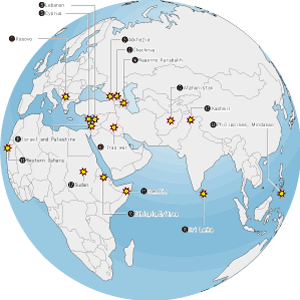A "Peace Court" to prevent wars
It is estimated there are more than 250,000 child soldiers in the world. In Japan, war is part of our past, but in other countries, wars are killing people at this very moment and stealing away children's hopes and dreams.
 |
| a picture painted by a 16-year-old girl in war-torn Sri Lanka |
The junior writers for Peace Seeds looked into the number of wars and conflicts now occurring in the world. We found there are at least 16, as of the end of January 2007. And in January, the "Doomsday Clock" was set to five minutes before midnight because of the nuclear troubles with North Korea and Iran. So, for us all, war is never very far away.
How can we avoid these senseless conflicts? We discussed the difficulty of growing up in such a frightening world and we hit on one possibility for preventing the use of force. Perhaps this idea won't seem feasible, but we hope it will inspire you to think of potential solutions, too.
Current Wars and Conflicts
In those 16 wars, the most frequent cause of conflict is a disagreement over territory (12 cases). This is followed by ethnic conflict (9 cases), religious conflict (6 cases), a dispute over political power (3 cases), and terrorism (2 cases). In fact, these wars can't really be classified in such a simple way-since some wars are a complicated mix of causes-but we tried to determine the main causes.
Many of these wars are occurring in Europe, with three taking place in parts of the former Soviet Union. The Middle East and Africa also have serious conflicts, though North and South America aren't currently troubled by wars within their borders. (Hayato Yoshioka, 15)
Establishing a Peace Court
The whole world could have a voice
Our virtual nation, Peace Seeds, proposes a "Peace Court" to prevent quarreling parties from resorting to arms. This Peace Court would be open to all disputes and decisions would be made based on a fair vote. (Haruna Tanabe, 17, Shoko Tagaya, 16 and Shiori Kosaka, 11)
|
|||||||||||||||||||||||||||||||||||||
Researching conflict prevention
Noriko Sado, associate professor at Hiroshima Shudo University
We interviewed Noriko Sado, a teacher at Hiroshima Shudo University, who has been researching conflict prevention.(Shoko Tagaya, 16 and Kotaro Tsuchida, 14)
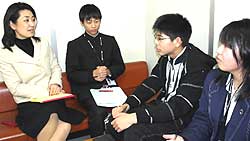 |
| Associate professor Sado, answering Junior writers about conflict prevention (left), photo by Haruna Tanabe, 17 |
| Noriko Sado, 34, is a specialist in international security and conflict prevention. She received her PhD from Osaka University and has been an associate professor at Hiroshima Shudo University since 2005, after working as a research fellow in the Japan Institute of International Affairs. |
Q: We found that wars or other conflicts are taking place in 16 regions. Were those conflicts inevitable?
A: I think they might have been avoided. The important thing is listening to the voices of the local people-what the problem is and what they want-through international organizations such as the UN or NGOs. For example, if the conflict is between nations or ethnic groups, we can investigate the cause and mediate it or take other measures to resolve it. I don't think enough effort has been made to prevent these conflicts.
Q: What about conflicts based on religious differences?
A: We shouldn"t overlook the real causes that exist behind a "war of religion." In fact, these wars break out not because of differences of belief, but because one religious group dominates the other politically. Negotiations between the two groups can help resolve this sort of conflict.
It's important to identify the likely causes that can trigger a war. And we must remember that, once a war starts, we can lose all the things we're fighting over, including our own lives, our family's lives, and our possessions.
Q: Do you think Japan is now at peace?
A: I think so, because Japan is fairly prosperous and isn't engaged in war. However, it's sad if our country can enjoy peace while other countries must suffer with conflict due to our own lack of effort.
Q: What do you think about our Peace Court?
A: For domestic conflicts, I think it's helpful that other countries and individuals can petition the court. It's interesting, too, that the countries which take part in the vote can also receive benefit from the judgment. Another important point is that the court's primary aim is to solve conflicts peacefully.
| Click the start button to listen to Professor Sado's message (Japanese) |
Peace Builders Company, an NPO Chie Fuji

I interviewed Chie Fuji ,38, who began working with refugees in 1993. She now runs a new NPO in Hiroshima called Peace Builders Company. She discussed her experiences in Africa. (Chinatsu Kawamoto, 14)
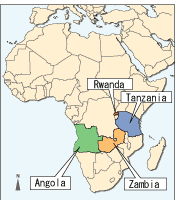
In 1994 I went to Tanzania to help at the Rwandan refugee camps. Thousands of people were dying each day, not only from fighting between ethnic groups but also from a cholera epidemic. I wanted the world to know that these people were dying because they didn't have enough fuel to boil their water.
I also saw many children become victims of war. In 1990, during the conflict in Angola, I saw some child soldiers carrying guns. But when I gave a toy car to a 10-year-old boy, he was delighted to have it. I realized that the victims of war are generally the weak, like children, and that we have to make a better world for them.
I'll always remember one boy, almost 15 years old, who I met at a refugee camp for Angolans in Zambia. His dream was to become a doctor. But because he was a refugee, he had to prepare a lot of documents and pay a higher tuition fee than the Zambians. He thought, "Just because I'm a refugee, I can't realize my dream. It's so unfair." But he transformed this anger into positive action. My co-worker and I helped him overcome these problems and, at last, he entered the best university in Zambia. Unfortunately, we can't offer such support to everyone, but I try to provide hope through assistance with skill training.
|
Pictures from Chie's album Crick to view larger image | ||
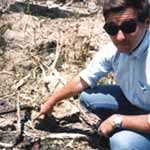
|

|
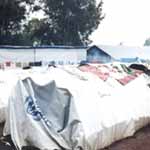
|
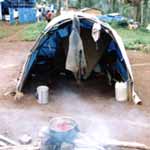
|

|
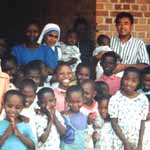
|
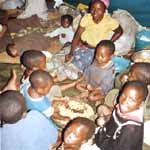
|
- The Doomsday Clock
The Doomsday Clock shows how close we are to the destruction of the world ("midnight") from nuclear war. Supervised by a journal concerned with nuclear issues, it measures the relative security of the world. In 1953, when both the United States and the former Soviet Union tested hydrogen bombs, it was set to two minutes to midnight-the closest the clock has been to midnight.
- Iraq War
Begun on March 20, 2003, without authorization from the UN Security Council, America and England invaded Iraq to find weapons of mass destruction. After Saddam Hussein's regime was overthrown, George W. Bush announced the end of the war, but the conflict has grown worse since then. Over 3000 American soldiers have died in this conflict and at least 50,000 Iraqis have lost their lives (as of February 11, 2007). No weapons of mass destruction have been found.
- Rwandan refugee camp
In April 1994, the ethnic conflict between Tutsis and Hutu resulted in genocide, claiming about 580,000 victims and forcing more than 2,000,000 people to live in refugee camps in neighboring countries.
- The Angolan conflict
After Angola attained independence in 1975, conflict between armed groups continued until 2002. According to UN statistics, this conflict produced more than 1,000,000 dead, about 4,000,000 refugees within the country, and another 500,000 refugees in other countries.
 Europe, including states of the former Soviet Union
Europe, including states of the former Soviet Union